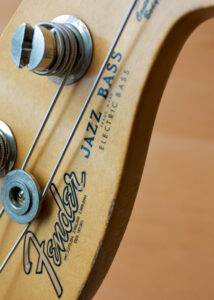 I have this bass – a 2014 Fender Jazz Road Worn, which I got in 2014. The road worn/relic basses get a bad rap because “it’s like buying jeans with holes in them already,” but they’re also the cheapest way to get a lacquer finish bass from Fender. That and the fact that they kiln-dry the wood before assembly means the wood is dense and low-moisture, which gives you a deeper sound and a lighter weight. Anyway, I like the bass. But I haven’t played it lately because the neck went all psycho on me, and it had a ton of action. From the side, it looked more like a bow and arrow. And I couldn’t fix it with truss rod adjustments. So much like my retirement planning and general health, I ignored it and hoped someday I’d have a chance to figure it all out, but not now.
I have this bass – a 2014 Fender Jazz Road Worn, which I got in 2014. The road worn/relic basses get a bad rap because “it’s like buying jeans with holes in them already,” but they’re also the cheapest way to get a lacquer finish bass from Fender. That and the fact that they kiln-dry the wood before assembly means the wood is dense and low-moisture, which gives you a deeper sound and a lighter weight. Anyway, I like the bass. But I haven’t played it lately because the neck went all psycho on me, and it had a ton of action. From the side, it looked more like a bow and arrow. And I couldn’t fix it with truss rod adjustments. So much like my retirement planning and general health, I ignored it and hoped someday I’d have a chance to figure it all out, but not now.
So then this music repair shop opens up about a block or two from my house. They are called Wood Street Guitar Repair. I brought the bass in to get a verdict on if the neck was completely destroyed or not. That’s when I saw what instantly sold me on the place: they had a brand new Plek machine, straight from Germany. I was in like flint.
A Plek machine is crazy. Basically, you strap a guitar into this thing that looks like a phone booth-sized 3-D printer. It scans the entire neck and loads the scan into a computer, which can then determine what frets are out of whack. The computer can then futz with this virtual model and simulate exactly what can be done to fix things. Once the operator picks a set of adjustments, a robot arm with a 50,000-RPM cutting tool buzzes away and files down high frets and does whatever other minor cutting and deburring and polishing needs to be done.
This whole process used to be done by hand, by sight. Now it’s done within a thousandth of an inch by a machine. Here’s a good video on how Gibson uses Plek now. I got a Lakland bass a few years ago, and they Plek every instrument they sell. That Lakland (a Skyline 44-01) has one of the best necks I have ever played, and it is their cheapest budget model. It’s truly revolutionary stuff.
When I checked in the bass, they asked me all the questions on how I like to play, what strings I wanted to use, etc. They also popped the neck and checked the truss rod, and it was still adjusting, so that looked okay. Unfortunately, when they got into it a couple of weeks later, they could not get the neck close to level, even with the truss rod bottomed out. So they heat-pressed the neck first. Basically, they put the neck in some clamps and use heat blankets to heat up the wood and slightly melt the glue. The neck is held straight and then dries overnight. They did this, then ran it through the Plek, and hand-filed the fret edges, which were a little too sharp.
Anyway, the verdict is that the bass now plays like butter. Super-low action, and it feels great. No high spots, just an incredible feel to it. I now have two great basses for slightly different purposes. The Lakland has active soapbar pickups and a very “fast” neck, a good combination for more modern metal or prog-rock. The Fender has passive 60s-style Fender pickups and a slightly chunkier neck, which feels great for old seventies rock. The guys at Wood Street Guitar did a great job – if you’re in the Bay Area, check them out.
Leave a Reply